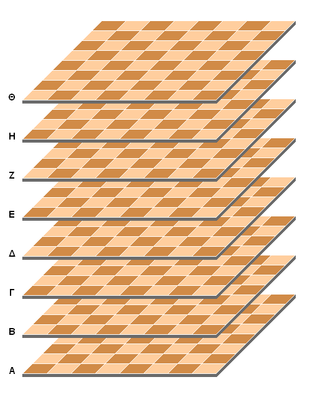
Three-dimensional chess (or 3‑D chess) is any chess variant that replaces the two-dimensional board with a three-dimensional array of cells between which the pieces can move. In practice, this is usually achieved by boards representing different layers being laid out next to each other. Three-dimensional chess has often appeared in science fiction—the Star Trek franchise in particular—contributing to the game's familiarity.
Three-dimensional variants have existed since at least the late 19th century, one of the oldest being Raumschach (German for "Space chess"), invented in 1907 by Ferdinand Maack and considered the classic 3‑D game.[1] Chapter 25 of David Pritchard's The Classified Encyclopedia of Chess Variants discusses some 50 such variations extending chess to three dimensions as well as a handful of higher-dimensional variants. Chapter 11 covers variants using multiple boards normally set side by side which can also be considered to add an extra dimension to chess.[2]
The expression "Three-dimensional chess" is sometimes used as a colloquial metaphor to describe complex, dynamic systems with many competing entities and interests, including politics, diplomacy and warfare. To describe an individual as "playing three-dimensional chess" implies a higher-order understanding and mastery of the system beyond the comprehension of their peers or ordinary observers, who are implied to be "playing" regular chess.[3]
- ^ Pritchard (2007), p. 229.
- ^ Pritchard (2007), p. 93.
- ^ e.g.
- "Obama is playing three-dimensional chess". Daily Kos. Kos Media, LLC. Retrieved 24 July 2017.
- "The enduring appeal of seeing Trump as chess-master in chief". The New York Times Magazine. The New York Times Company. 2017-05-31. Retrieved 25 July 2017.
- "How the Ukrainian crisis is like three-dimensional chess". Monkey Cage. Washington Post. 2015-03-15. Retrieved 2018-08-15.